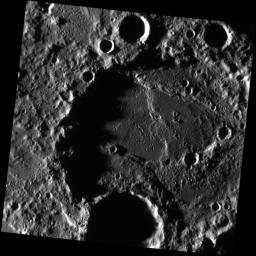
|
Wrinkles in the Cloth of Time
- Click the image above for a larger view
- Full-Res JPEG (1125 x 1126) (172.9 kB)
- Full-Res TIFF (1125 x 1126) (1.3 MB)
Caption:
The floor of this unnamed crater is crossed by wrinkle ridges in at least two directions, suggesting that it has been tectonically modified several times in its history. By mapping the extent of these kind of scarps , scientists can determine how much contraction Mercury experienced as it cooled.
This image was acquired as part of MDIS's high-incidence-angle base map. The high-incidence-angle base map complements the surface morphology base map of MESSENGER's primary mission that was acquired under generally more moderate incidence angles. High incidence angles, achieved when the Sun is near the horizon, result in long shadows that accentuate the small-scale topography of geologic features. The high-incidence-angle base map was acquired with an average resolution of 200 meters/pixel.
Date acquired:
July 20, 2012
Image Mission Elapsed Time (MET):
251261951
Image ID:
2234041
Instrument:
Narrow Angle Camera (NAC) of the Mercury Dual Imaging System (MDIS)
Center Latitude:
-58.46°
Center Longitude:
146.3° E
Resolution:
163 meters/pixel
Scale:
The large unnamed crater is approximately 131 km (81 mi.) across.
Incidence Angle:
86.5°
Emission Angle:
0.9°
Phase Angle:
87.3°
Background Info:
The MESSENGER spacecraft is the first ever to orbit the planet Mercury, and the spacecraft's seven scientific instruments and radio science investigation are unraveling the history and evolution of the Solar System's innermost planet. MESSENGER acquired over 150,000 images and extensive other data sets. MESSENGER is capable of continuing orbital operations until early 2015.
For information regarding the use of images, see the MESSENGER image use policy .
Cataloging Keywords:
| Name | Value | Additional Values |
|---|---|---|
| Target | Mercury | |
| System | ||
| Target Type | Planet | |
| Mission | MESSENGER | |
| Instrument Host | MESSENGER | |
| Host Type | Orbiter | |
| Instrument | Mercury Dual Imaging System (MDIS) | |
| Detector | Narrow Angle Camera (NAC) | |
| Extra Keywords | Crater, Grayscale, Map, Radio, Shadow | |
| Acquisition Date | ||
| Release Date | 2013-06-05 | |
| Date in Caption | 2012-07-20 | |
| Image Credit | NASA/Johns Hopkins University Applied Physics Laboratory/Carnegie Institution of Washington | |
| Source | photojournal.jpl.nasa.gov/catalog/PIA17233 | |
| Identifier | PIA17233 | |
